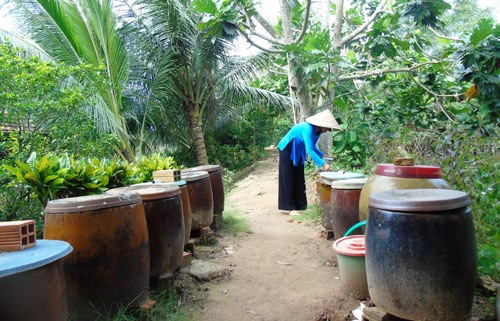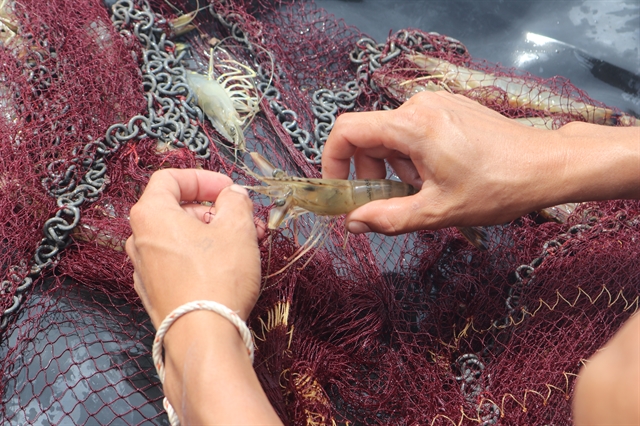 Society
Society

On a recent sunny day, Phan Thị Kim Ngân, 53, wore an old palm-leaf conical hat, as she removed the cover of a barrel containing traditional fish sauce in her garden in Cồn Sơn Commune in the Mekong Delta City of Cần Thơ.
 |
| Ngân removes a cover from a barrel of traditional fish sauce in her garden.— Photo danviet.vn |
CẦN THƠ — On a recent sunny day, Phan Thị Kim Ngân, 53, wore an old palm-leaf conical hat, as she removed the cover of a barrel containing traditional fish sauce in her garden in Cồn Sơn Commune in the Mekong Delta City of Cần Thơ.
Ngân’s family is the only household in the commune still making the traditional fish sauce from Siamese mud carp and freshwater anchovy.
The Siamese mud carp and freshwater anchovy often appear in local rivers between October and February following the lunar calendar each year, Ngân said.
The fish sauce making process begins when she buys the fresh fish from local fishermen. Then, the fish is washed with water, put into barrels and marinated with salt.
Ngân said that for the best quality of traditional fish sauce, the salt should be the type of salt that was dried for a long time in the Mekong Delta
“The kind of salt will make the fish sauce have the strong taste as it should,” she said.
The ratio is 15 kilos of salt for every 30 kilos of freshwater anchovy, the Nông thôn ngày nay (Countryside today) newspaper reported.
For the Siamese mud carp, the recipe is a little more complicated. In the first four hours, she puts six kilos of salt into every 30 kilos of the Siamese mud carp. In the next 24 hours, she continues pouring an additional nine kilos of salt.
Then, the fish is kept in the barrels with tight covers for nine to 12 months. She decides when the fish is ready based on the smell. When the smell is right, she will take both the fish and the sauce for boiling. Finally, after she filters the fish bones, she gets a pot of fish sauce.
“Every 30 kilos of fish will produce about 22 litres of traditional fish sauce,” she added.
The typical price for a litre of traditional fish sauce is about VNĐ30,000 (US$1.32). Ngân said she bought about 300-500 kilos of the two types of fish for making the traditional fish sauce each year.
Traditional fish sauce preservation
At first, Ngân just wanted to make the traditional fish sauce for family usage and then to sell to local residents as well as tourists.
Two years ago, a representative of a major domestic fish sauce firm came and asked her whether she wanted to sell her traditional fish sauce for them. They would buy the traditional fish sauce she made for a price five to seven times higher than the one she was charging friends and neighbors.
They hoped to buy Ngân’s traditional fish sauce and then mix it with other ingredients to produce industrial fish sauce on a massive scale, but Ngân rejected the offer.
“There are only a few people making traditional fish sauce now,” she added.
Additionally, the amount of the traditional fish sauce she makes each year is small.
“If I sell all for the firm, no one could taste the real flavor of the traditional fish sauce I’ve made,” she said.
She learnt the recipe from her father.
“All I want to do is keep the flavor of the traditional fish sauce as long as I can,” she said.
Hoàng Hải Yến of
“I love the strong taste of the fish sauce so much,” Yến said.
That was the taste that industrial fish sauce never has, she added.
An overseas Vietnamese, born in Cần Thơ City’s Cái Răng District, said she bought a lot of the traditional fish sauce made by Ngân every time she returned the city.
"Because the strong taste of the traditional fish sauce makes me recall my childhood so much," she said.
Võ Văn Tho, head of the Bùi Hữu Nghĩa Ward, said that in the past the ward had 79 households that made traditional fish sauce. However, people shifted to do other things to earn more money.
Only Ngân continues making the traditional fish sauce, he said.
According to Tho, in 2016, the ward administration helped Ngân to borrow VNĐ 50 million (US$2,200) with no interest for five years so that Ngân could buy three tonnes of Siamese mud carp and freshwater anchovy to make the traditional fish sauce to serve tourists who visited to the commune as she expected. —VNS




